Chapter 11 Irrigation - Wyambi and Mt. Cameron Water Race
Abundant fresh runing water has been an invaluable asset for good cattle production on our properties. Wyambi is served by an old mining race, some seven miles in extent. It used to supply tin mines which are not operating now. This main race was extended by another six miles, plus irrigation races.
It was a major job to cut through three-quarters of a mile of solid granite and other hard rock to get the water to one section of our property. We sought the advice of engineers, who, after viewing the area, said it was an impossibility, so we decided not to go ahead, and unfortunately my son was drowned on the property soon afterwards.
Then Tas Rainbow, who is a miner and whose father, Bill, was a meticulous person and very knowledgeable, rang me and asked me to buy the system. I declined, mentioning that my son had been drowned.
But
, said Tas, you'll have to buy it; I want to buy a house
.
So I gave him $100 for a six week option, and, after we began going
into the matter, I bought it.
Incidentally, Tas's father Bill and my brother Reg, who both died recently, were prisoners-of-war of the Japanese and assigned to work on the Burma Road.[*] They had a tough time, and I understand that Bill, when someone offered to take him to an RSL meeting, did not want to go because he would be travelling in a Japanese car.
[*] There is a very good book available regarding the prisoners-of-war on the Burma Road - 'What Price Surrender?' by Desmond Jackson.
Bill was a terrific person. The previous Director of Mines, Jack Symons, said it was just fantastic to see Bill's power house, where he used to pump his water. It was just spotlessly clean, and Tas, just like his father, is very mechanically-minded and very bright.
I paid Tas $1500 for the water race, and then had the 'impos-
sible' job of extending it another three miles to our property. An
engineer from a firm in New South Wales, who visited the property,
said it was an impossibility and would break the Bank of England to
cut through three-quarters of a mile of granite. You just cannot do
it
, he declared.
I went to Hobart and asked the Chief Engineer of the Rivers and
Waters Commission if he could help us do this work. Of course
,
he said, you would want it done yesterday, but we could not do it for
a couple of years. I am afraid I cannot help you
.
I told him we intended to build it through the bush at a fall of one in a thousand. When you think that mining races are pretty level at one in 600, or half an inch in a chain (the old measurement), you will realise that one in a thousand is fairly level!
Yes
, said the Chief Engineer, And who is going to survey
it?
I replied that I was, and he replied, Well, if you can survey it
that is good
.
So, as I had my dinner in Hobart, I was thinking that we had three hills to cross with cuttings of about 35 feet deep. I could see I had a bit of mathematics to do. I concluded that if we laid the race at one in 2500 it would be much closer to being level and we would have only about 6 foot cuts, which would be nothing on those hills, whereas a 35 foot cut was really a big excavation.
So I rang the Chief Engineer back and told him. He replied, I
think that is what I would have done myself
. But I think he thought
we would not be capable of building it so level through the bush and
rocks.
But we used a 'dozer and ripped the rocks away wherever we could, and blasted them out, and in other places we 'dozed down tens of thousands of yards of clay soil and laid clay banks for the water to run around the rocks - and, in short, we got it around and extended the water race into Wyambi.
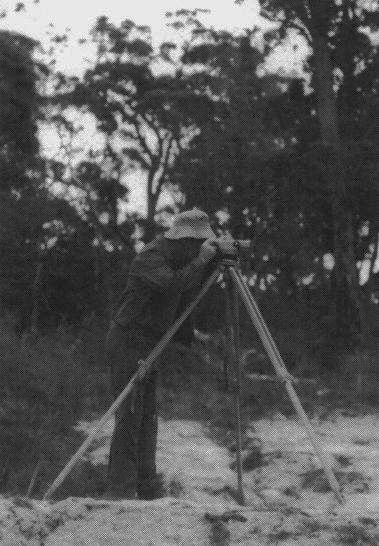
1980 I am surveying for a new dam site
So we built it - and we started building dams at the same time. We built a big dam of some 45 million gallons on the boundary, extending the water race on a contour of one in 2000, which meant a fall of one foot in 2000 feet, to the centre of the Wyambi property.
When Joe (the Chief Engineer) came up to see another proposition
and visited our property he said, It won't run
.
'Why not?' I asked, and he replied, You cannot build it over 20 miles like that, with
dams and races, and expect them all to line up. It does not work out
that way; things are not so simple
.
For instance
, he asked, how are you going to get through that
gully of rocks there?
This was in Wyambi, not on the three-quarter
mile original section of rocks.
I said that we would just dam the creek up in places and would
blast and 'doze, to which he replied, Come hell and high water you
are going to do it, and I wish you luck
, and even the contractor said
after working there a couple of months, These races won't work
.
Why?
I asked, to which he replied, I have just done some five
miles of races for the Mines Department, and neither of them ran; they
made some mistake in the surveying
. I told him we would not make
a mistake, and his reply was, Everyone makes mistakes
. When the
engineer laid the water scheme to Kalgoorlie he was really concerned
that it was not flowing through, and he thought it was a failure and
unfortunately shot himself. This was dreadful, because he was a great
engineer. However, I jokingly told visitors when they were admiring
the project that although we also had the gun loaded, we did not get
around to pulling the trigger!
Anyhow, we could not afford to make mistakes, so we watched our levels pretty well and the whole scheme did operate. Then we built a third dam! It was written up in the 'Farm Magazine' in January 1985...
Bert Farquhar has developed what must surely be one of the most ambitious and efficient farm water and irrigation systems in Australia. It has a total storage capacity of 860 megalitres and 53 kilometres of channels without one pump for collection or distribution. This extensive system came about because Farquhar wanted to ensure steers could be finished over summer and autumn on his north-east Tasmanian property, 'Wyambi.'
The scheme allowed us to have green pastures for the cattle in the summertime, and to allow cattle to have plenty of fresh water all the year round which is really essential for grazing.
We are very fortunate to have this water plus a good mild climate whereas farmers in parts of the Northern Hemisphere operate under very difficult conditions. They have snow and sleet and everything frozen over during the winter, which makes their operation very expensive, for they have to shed their cattle and do all sorts of things to keep them in good condition. We have everything in our favour.
When in California in 1956 I mentioned to my farmer host that our winters were mild compared to theirs - so mild that all our broad-leaved trees were evergreens whereas practically all of theirs were deciduous. He was amazed, but he realised it was true.
On our property our cattle can feed all the winter, as we have never had snow to stop growth. However, although we do have mild winters in Australia we can miss Out in the summertime.
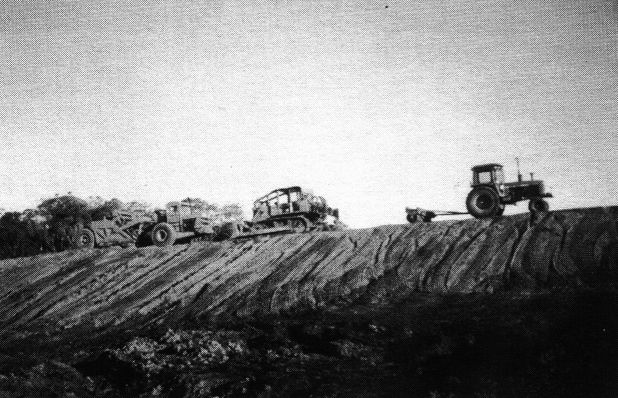
Construction of Black Boy dam - George Reynolds scraper
Arthur Dobson - dozer and Bob Jensen - tractor.
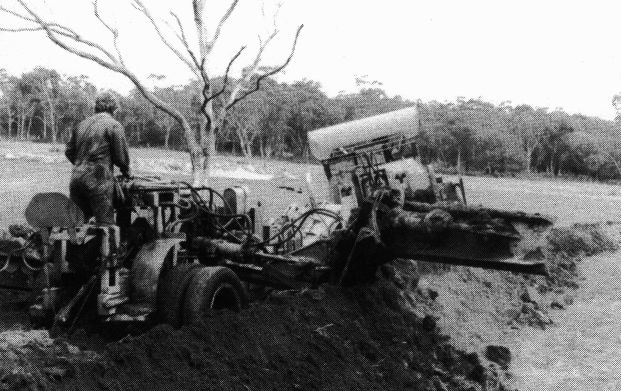
1980 Rodney Moore and Michael Groves constructing irrigation races through 'Wyambi'.
Some 53 kilometres (33 miles) were built requiring much accurate surveying.
Grades varied according to use, i.e. for water channels or directly for irrigation.
All banks were sown with grass and consolidated before irrigation commenced.
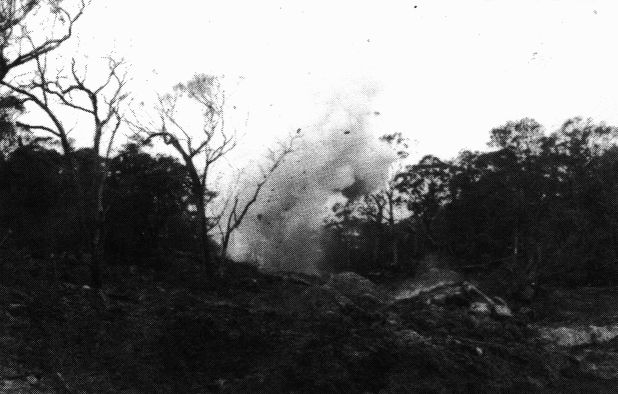
1980 Rock blasting during construction of race through 'Wyambi'.
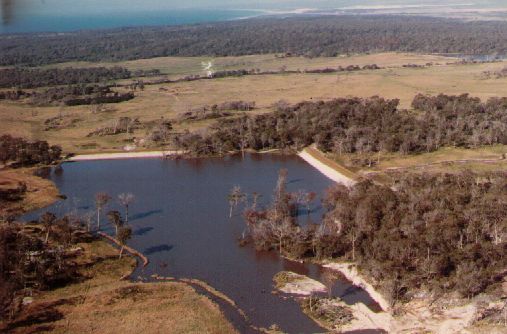
1981 Black Boy dam three parts full. When full - depth approximately 13.1 metres (43 feet)
Area 16.5 ha (41 acres).
Smaller 68,191,350 litre (15,000,000 gallon) dam shown on top right hand corner.
Also shows trees left for shelter and ocean in background.
In parts of Australia cattle put on a lot of weight in the wet season when the grass is green, and then lose two-thirds of their condition in the dry period. We in Tasmania are not in that position, but our stock can lose a lot in the dry period if we are not careful. The deterioration of the cattle condition can be quite spectacular. You can go around your cattle early in March and they all seem fat, then if you don't see them for two or three weeks they can appear thin. The dry weather and cold nights can soon wreak havoc with a mob of fat cattle, as well as havoc with your bank balance. So it is important that we use water to the best advantage.
In Tasmania all our water springs from the centre of the island and runs towards the coast, so we have all our water in the top of our head, one might say, and we all should use it to the best advantage. But I am afraid that is not being done at the moment.
In Central Australia the situation is different, for there is not the water to radiate out towards the coast. More water should be turned inland over the Dividing Range - but I have dealt with this aspect in another part of this book, in relation to the Bradfield Scheme.
It is obvious that if pastures are irrigated the worms keep breeding more quickly with added benefit, and of course there is a lot more clover in the summer. Clover extracts nitrogen from the air and, through the nodules on its roots, stores it in the ground for the grass to absorb.
For irrigation on our property we use wild flooding. We do not try to level ground and cover pastures as they do in Victorian irrigation areas. Of course, when you crop you have to level with a laser and machinery and, although worthwhile, that costs a lot of money. But in our case, we just want to use the water to its best advantage, and cheaply.
We realise that wild flooding is rather hit and miss, but the little dry pasture among the green in the area irrigated is an advantage for cattle grazing.
As mentioned before, cattle need only 40 per cent protein and 60 per cent roughage, so if there is a little bit of green in the top-dressed pastures they can eat a lot more dry roughage with it and do quite well.
We have 33 miles of gravity races on Wyambi without the need to pump. With a gravitation race the water just gravitates or it goes around the sides of the hills in a circle, so you follow the contours and work the water right through your property.
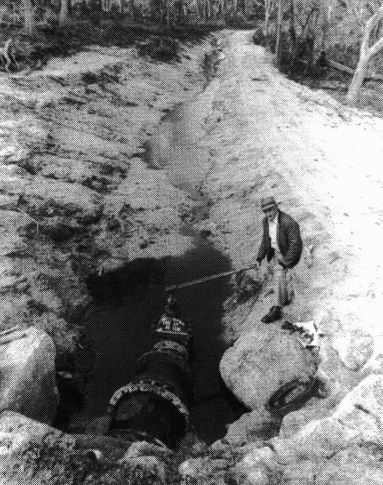
1982 I am turning on valve at Boundary Dam.
204,574,050 litre (45,000,000 gallon) capacity.
To assist in this task, contour maps are available from the Lands Department. They are quite accurate and they will help you quite a lot when you plan to build your irrigation channels. But of course you have to get sophisticated levels and so on to survey right through. We put quite big valves on the dams. Our biggest dam, 'Black Boy,' is about in the centre of the property; it is more or less on the highest pinnacle. The dam holds 140 million gallons of water and covers 41 acres, and we put on 21 tons of dirt and rock every four minutes for some months on a great big wall.
When constructing the dam we put some big 24 inch and 26 inch valves in to let the water flow out quickly to flush over the paddock, which is 20 chains or a quarter of a mile long. You really need to allow the water to run flat out for two-thirds of that distance and then turn it off. The rest will soak right through.
We have a 24-hour alarm clock which will automatically drop shutters on the irrigation stops, but we don't generally use them, as the paddocks are so big. We could do this automatically, but, although it is quite successful, we have not bothered to use it a lot.
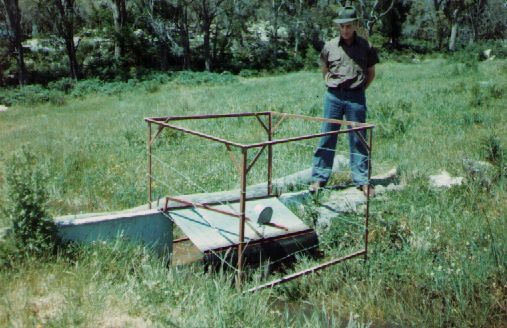
1984 David Probert setting alarm clock to drop gate for automatic
flooding of pastures, watched by me.
We do put concrete stops in the earthen irrigation channel, which is part of the scheme. It has a fall of one in 600. To do this you survey off about 100 metres on the channel and put a concrete stop in, leaving a gap in the centre. Then, in this gap, you place a galvanised door with a rubber flange, which just stops the water.
Then you go back and survey to the next stop, 100 metres further back. You then survey for three or four outlets, which you just dig into the side of the bank. Do this on every rise, because water will soon work into the gullies. When the door is closed the race builds up and the water will pour through over the grass. You let that go for about 12 hours; then put a door further down and do the next bay.
That, of course, will do a great many acres in the meantime. It is a cheap method of irrigation, more economical, water-wise, than spraying. For dairying and vegetable crops probably you would spray, but for beef cattle I doubt whether it would be desirable, and it is certainly more economical to flood the pasture.
Peg and I have seen irrigation schemes throughout the world in China, India and America, and, on paper, it would seem that their government schemes are unpayable. I do not think any government irrigation scheme has paid, but China and India could not support their vast populations without irrigation.
A great many people do not realise that, although on paper, the government schemes show a loss, they have a benefit in that they allow the price of food to be kept down. Imagine what it would be like in those countries if there were no irrigation and there were a drought.
When my brother and I started farming in our teens there was very little irrigation in Tasmania. When we had a really good season there was plenty of produce, but in a poor season there was very little. Even then, the benefit of irrigation was apparent.
If Bill Jones had his farm irrigated and Jack Smith did not, Jack had to sell his cattle during a drought. But Bill was in a position to buy them. His modest irrigation scheme enabled him to do this, and it also helped Jack, for he had a market for his stock.
On the mainland of Australia often there are good rains in some areas and poor rains in others. That enables stock to be moved around.
America and Canada could not supply the vast quantities of grains and foods for the world if it were not for their vast irrigation schemes.
In our case, however, the irrigation scheme on Wyambi had to pay, and it had to be done without government assistance, financial or otherwise. Of course, its cost can be taken off our income over a period when assessing income tax, but we have to earn the income first.
It is different for people on a government scheme. The scheme just put in at Winnaleah, which is a great asset to the North-East of Tasmania, cost the government six and a half million dollars, and it will never get its money back directly, but indirectly it may do. It probably will not get five per cent interest on its money laid out, whereas I have to pay 16 per cent on mine.
During the time we were developing our property we had a lot of visitors to Wyambi because it was so successfull and among them were Senators and other members of Parliament. I suggested to them at the time that they try to stop the Mt. Cameron water race at Gladstone from being sold and scrapped so it could be kept in case it was needed in the future. Of course, I never thought Cascade would ever sell Rushy Lagoon and I could bid for it and buy it.
The Mt. Cameron Water Race was a great scheme to take gravity-fed water around the hills and from one hill right across a deep gully up on the next hill, by a great four kilometre/76 centimetre syphon. The syphon will operate as long as the outlet is about six feet below the intake of the pipe column.
I also wrote to the Cascade board and suggested that Cascade take over the Mt. Cameron water race, because they owned Rushy Lagoon, which was the only property that could use this water to advantage. However, they must have thought it was too big a project and did not even bother to answer my letter. I had thought it would be a great asset to Rushy Lagoon and to the State.
If dismantled and sold it would bring only a few thousand dollars whereas it would cost many millions of dollars to build it today. One recent 1990 estimate of the whole water scheme was $10,000,000. I felt its loss would be a national disaster.
So when Cascade later decided to sell Rushy Lagoon, and advertised that it would be auctioned in about six weeks, I was particularly interested, especially when it was published in the press that the Mt. Cameron Water Race Authority had been disbanded and was selling its assets, including the two big concrete syphons, over two miles in length, as well as the valves out of the Big Chum Dam. They intended to breach the dam - in fact, blow it up.
Before this I had become interested in trying to buy Rushy Lagoon at public auction, and David Probert, my overseer, and Rodney Moore, my present sheep manager who had been with us for a number of years, knew a lot about the water race. I tendered for the race and before the sale of Rushy Lagoon I found that, although the tenders had not been finalised, my tender was the highest and I was going to be able to purchase it.
The Director of Mines, Hugh Murchie who was chairman of the Mt. Cameron Water Race Authority, said tome, 'If you buy the valves from the dam and the pipes out of the syphons (it would have been really an act of vandalism to dismantle this enormous syphon of two and a half miles in length) the water scheme will belong to you, and land my Government would be pleased to see it used again instead of being scrapped, for it had been operating for 100 years and is one of the biggest schemes of its kind, if not the biggest, in Australia.'
So I was able to go to the sale of Cascade knowing I would have this beautiful water scheme available for development of the property if! could buy it. And we felt we could put the water scheme throughout Rushy Lagoon, a distance of some 25 miles.
Most people had thought it was just a pipe dream and that there was no way we could really do it. They said the actual cost would be enormous and it would be nearly impossible to get the water right through by gravitation.
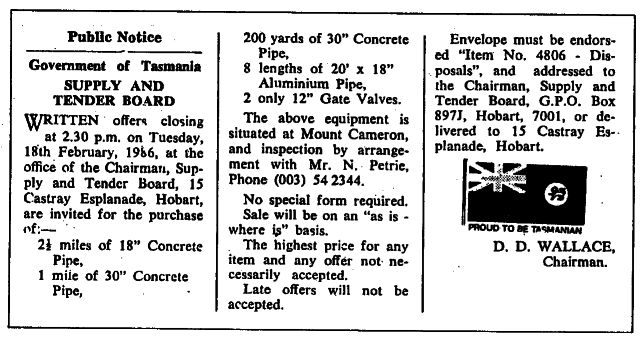
Mt Cameron Public Notice
However, 1 guess we were fortunate that we were able to accomplish this major project. It entailed much research and meticu- 133bus surveying, mainly by Rodney Moore, David Probert and myself. Marg, my secretary, as always, provided invaluable assistance with maps and written grades etc.
Now with the extensive irrigation scheme put in, with more than adequate water available, plus the development of the river flats (where the grass naturally keeps green all summer) there will always be a reasonable amount of green feed and growth during the summer and autumn. The irrigation schemes could not be put in today for $10 million as it dates back 100 years giving it right of way through State Forests and Crown Lands.
We have received no Federal, State or Local Government financial assistance to get this big irrigation scheme in operation, although millions of dollars of public money have been spent on other schemes of a similar size in the State.
There is a brief history of the Mt. Cameron Water Race which I will put in the book.
A complete book is being written on it by the Mines Department; this will be a major job and I guess that will be ready in a year or two and should be very interesting.
This race is one of the most fantastic schemes in Australia, and it compares quite favourably with many of the schemes supplying water cheaply throughout the world.
Mount Cameron Water Race - A Brief History
Do you believe in reincarnation? If you happened to be the Mount Cameron Water Race, you certainly would
Most people have never seen this water race. Some have looked at it, driven over it, walked along its banks, maybe even fallen into it without knowing what the hell it was.
For over a century, it was the lifeline for the local tin mining industry around Gladstone in north-east Tasmania. The race is not the most spectacular of sights, in fact it may appear fairly mundane. It is however, a major engineering feat with an interesting history.
Built in three stages, the first section of 12.5 miles (20 km) was constructed from the Musselroe Creek to Edina Sugarloaf in 1882, by the Mount Cameron Hydraulic Tin Mining Company.
The second stage of development occurred when the State Government purchased the race from the ailing mining company in 1887. It was then extended south by 6 miles (10 km) to the Great Musselroe River, and north by 15 miles (24km) to Aberfoyle Hill. The main race, when completed in 1890, had increased in length to 33 miles (53 km) with a carrying capacity of 50 sluice-heads of water.
The third stage of development did not eventuate until 1922, when the main race was diverted across the Ringarooma River to service developing tin mines west of Gladstone. This 14 miles (22.5 km) section of race was known as the Western Deviation.
It was during the mid 1930's that the Mount Cameron Water Race Board maintained more than 60 miles (96 km) of race. However by 1985, this distance had been reduced by almost half.
During its long history, the race acted like a barometer in determining the fluctuations of the local tin mining industry. As new tin sections were opened up, so the race would be upgraded or modified to meet their demands for water. The race was abandoned or closed down where areas had been worked out. A typical example was the Ringarooma Syphon, which was constructed of pipes from disused syphons along the closed Northern Extension.
In 1984, the last tin mine (Musselroe) serviced by the race ceased operations. The following year Gladstone commenced pumping water from the Ringarooma River.
No longer required for mining and no longer supplying domestic water for the Gladstone township, the 103 year old water race seemed destined for oblivion.
However an enterprising farmer named Bert Farquhar had other ideas. The owner of Rushy Lagoon, the largest pastoral estate in north-east Tasmania, decided to incorporate the race in an exten- sive irrigation scheme for his property. During the past four years a programme of rehabilitation has been underway, upgrading the 33 miles (53 km) of main race from the intake on the Great Musselroe River through to the Government Reservoir near Aberfoyle Hill.
It is almost as if after a century of operation for one industry, it has been reincarnated into a new life ofserving another industry. Will this secure its future for the next 100 years?
Greg Dickens June 1990